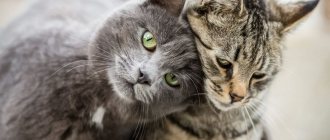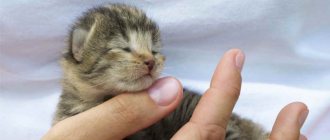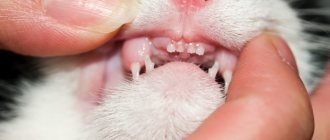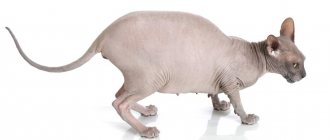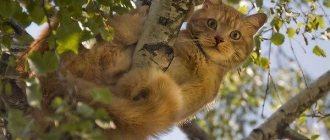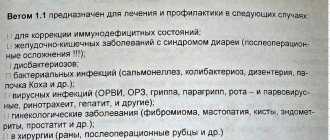Why do cats wag their tail?
Ethologists say that pets can move their tails in completely different ways, in this way expressing their feelings and emotions - both positive and negative - at a given time.
The more intensely the cat twitches its tail, the more vivid experiences it experiences. Of course, each cat has its own characteristics and behavior. Therefore, relying on already known interpretations of non-verbal “body language” signals given by animals using their tails, it is still better to focus on your own feelings and experience of communicating with your pet.
Now it’s clear why cats wag their tail - this is how they try to describe their state and mood at a certain period of time.
Wagging the tail can indicate different feelings in animals: it all depends on its speed and on the part of the tail involved in “communication”: a slight twitching of the tip indicates a relaxed state, if the tail gradually “unwinds” - the pet is ready to jump and pounce on the object of hunting.
- Slow vertical tail wagging will mean that the dog is very interested in something.
- Slowly wagging its tail, the pet is trying to make a choice and pondering the options.
- An animal demonstrates its contentment with something by holding its tail high. If at the same time its tip trembles a little, the cat is very happy about something, or is anticipating pleasure. Slightly arching its back and stretching its head forward, it greets the owner or its relative, while raising its tail with a pipe.
- Chaotic tail wagging performed by a resting pet indicates that the seemingly dozing animal is always alert and ready to act. When a cat falls into a sleepy state, the movements of the tail slow down and stop altogether when falling asleep.
If you see your favorite cat wagging its tail, what it means can be understood by the intensity of the waving and the movements it makes.
When hunting for small rodents or insects, the cat presses its tail to the ground, slightly twitching its tip and thereby betraying its excitement.
The twitching tip of the tail indicates a slight irritation that a pet may experience if, for example, its “rival” is nearby - another pet, be it a cat or a dog, caressed by the owner.
When a cat begins to strongly swing its tail and hit it in all directions on the floor and on its sides, you need to be careful: it is extremely hostile towards the object or subject at which its menacing gaze is fixed, and its claws and teeth. A fight or tearing apart of the hunted object is planned.
If a cat's tail sways quickly back and forth, it means the pet is terribly angry.
That is, if your cat is wagging its tail, you don’t have to be on guard - depending on the situation, this movement can be either a good or bad sign.
Why does a cat need a tail?
A cat's tail is an extension of its spine, which consists of vertebrae, blood vessels and nerve endings. This part of the animal's body is considered the weakest and very sensitive, which is why cats do not like their tails being touched. This part of the body serves to transfer the center of gravity when running fast or when walking, and maintains coordination of movements when jumping. Thanks to it, the owner can understand the cat’s mood, its further actions and well-being. The more intensely the cat swings it, the stronger his emotions.
How cats show their mood
A cat's tail consists of many vertebrae and performs a large number of functions. The main role is balancing during movement and hunting. But a cat's tail is also an expression of her behavior and character. This means that if the owner is attentive and loving, then it will be easy for him to determine the cat’s mood by the tail. It is when and how a cat shakes its tail that you can understand what mood it is in.
A cat's tail twitches in different ways - both vertically and horizontally. To figure out how to understand a cat by its tail, you need to take into account many factors. These may include:
- people unfamiliar and incomprehensible to them. For older cats, this can be a stressful environment. And if this is a cat with kittens, then the trembling tail will immediately let you understand displeasure and fear for its offspring;
- general situation in the breeder’s family. If you constantly scream and at the same time can periodically hit the kitten, you should be prepared for the fact that the cat arches its back and its tail is fluffed or tucked. But when you love and cherish your pet, then his tail will almost always be a pipe, and the threat of an arched back and hissing sounds will bypass you;
- If an animal beats its tail, meows, shakes, its pupils are dilated and it tucks or arches its tail, then the pet is letting you know that it is experiencing fear. In such a situation, it is better to remove the object that provoked panic;
- An unfamiliar environment or moving can also cause displeasure in the pet, which will be expressed in the fact that the cat jerks its fifth limb. Let her know that you are looking out for her and want the best for her.
Cats can perfectly understand what you are communicating with them about. As the kitten grows up, it learns to understand its owner, and you learn how to determine its mood and how to understand your pet’s language.
Why cats wag their tail or how to understand your pet
Every owner wants to understand the emotions of their pet. Since ancient times, cats were considered the most mysterious animals. But nothing is impossible. With patience, observation, and a little ingenuity, you can figure out why, why, and when cats wag their tails.
All cats are different in their behavior, temperament, habits and preferences. Long-term observation of them made it possible to identify some patterns that are characteristic of domestic cats. The behavior of a kitten is significantly different from that of an adult animal. The same can be said about adult or elderly pets.
It would seem how simple everything is with dogs. If she wags her tail, it means she is happy. When it comes to cats, even experienced owners do not always interpret the animal’s message correctly. Let's figure out why a cat constantly wags its tail in different ways, but first, a short course in physiology.
How cats communicate using their tails
It is not always possible to understand from the face how to determine the mood of the animal and figure out what the cat wants. And it is the cat’s tail that will tell you about all the thoughts and emotions of the pet. Let's look at specific examples of why and how a cat twitches its tail:
- The four-legged pet smoothly swings its tail horizontally in different directions. Cat experts indicate this gesture as the fact that she cannot immediately make a choice between her desires. When the decision is made, the animal will calm down and stop twitching;
- if a cat lifts its tail and puts it vertically, it tells you that the pet’s thoughts are very interested in something;
- a slight twitch indicates strong affection and love for you;
- if the cat’s fifth limb is down, it means that she is bored;
- the tail is up, but the back is arched and the ears are pressed back - the cat cannot decide whether to attack or defend. He is very scared;
- the tail is in a curved arc position and the cat arches its back - it senses danger and is ready to defend itself. In this state, do not hit her and try to calm her down;
- a tail raised up (vertically) indicates that the animal is in a great mood and is ready for games and communication;
- a loosely drooping tail tells that the pet is in a calm mood, but is not inclined to communicate;
- a measured and rather strong horizontal waving of the tail indicates dissatisfaction and irritation;
- a wary animal's tail is lowered and ruffled;
- only the tip of the tail moves slightly - at the moment the pet is in an excellent mood and is happy with everything that is happening around him;
- the cat’s tail trembles and moves horizontally in different directions faster and faster - the hunt is in full swing and an attack on the prey will occur in the coming seconds;
- a vertically extended, quivering tail denotes a playful mood. It’s worth considering here that if the movements become faster and sharper, the cat beats its tail and may start meowing - the animal is getting too excited and it’s time to stop it. This is especially true when playing with small children - the danger of scratches and bites from a cat is too great;
- a tail wrapped in a ring around the body speaks of an excellent mood and trust in the surrounding world;
- the tail is raised halfway - the pet is confused and cannot determine its attitude towards a person or animal - to understand whether it is a friend or an enemy;
- fluffy tail and fur along the spine - the cat is furious;
- a vertically raised tail may mean that the cat is marking territory;
- sharp waving or tapping indicates stress and possibly pain;
- biting the tail signals the presence of parasites;
- in cold weather, cats wrap their tail in a ring around themselves, thereby reducing heat transfer;
- a vertically raised tail with a relaxed tip indicates joyful excitement;
- sits or lies with the fifth limb calmly extended - the cat is resting;
- in a sitting position, with paws tucked and tail wrapped - the animal is relaxed, but waiting for some action;
- a slight twitching of the whole body along with the tail means happiness and calmness of the pet. You can observe this when stroking it, scratching its ears or back. Will also be expressed in loud purring and squinting of the eyes;
- a leisurely and rhythmic twitching of the tail vertically indicates interest in something. The cat is relaxed, does not feel danger and is concentrated on the object of its attention. It is also expressed in the fact that the animal walks around the object of its interest and sniffs it;
- the desire to attack can be expressed in walking the fifth limb from side to side. If this occurs when playing with inanimate objects, then there is no need to worry. As soon as the cat gets tired of this activity, it will move away from it and forget about it quite quickly. At least until the next surge in gaming activity.
Cats move their fifth limb almost constantly. There are many explanations for this fact. When communicating, you just need to pay attention to your pet’s mood. When there is mutual understanding between the owner and the pet, when they can understand and feel each other, then there will be practically no problems in communication.
Just listen to what your cat is telling you. Indeed, contrary to popular belief, tail twitching can also mean great love and devotion towards you.
How to tell how a cat is feeling by its tail
The movements of a cat's tail can serve as an indicator of health. Having fallen ill, the animal will begin to make movements that were previously unusual for it. This is a sign that you need to take a closer look at your pet’s behavior and, if you notice other warning signs, contact your veterinarian.
Attention!
Sharp twitching of the tail can be a signal that the animal has reached puberty and is experiencing excitement. If a pet shakes its tail when near a wall or piece of furniture, it means it is marking its territory.
The following table will help you understand what is happening in your pet’s body.
For all its simplicity, a cat's tail is capable of performing a wide variety of tasks. With its help, a pet can not only talk about its feelings, but also hint at its well-being. Therefore, it is so important for every responsible owner to know this special language.
A long flexible whip or a fluffy fox tail - any tail is undoubtedly the most noticeable “decoration” of a cat. But Nature, a tireless dreamer and a brilliant scientist rolled into one, probably endowed animals with this part of the skeleton for a reason. Let's figure out why a cat needs a tail and how mustachioed impatiens use this valuable gift of evolution.
A cat's spine consists of the cervical, thoracic, lumbar and sacral regions - sounds familiar, doesn't it? But then we see the differences between humans and cats: where our coccygeal part is located, in cats the tail begins - another part of the spine. The structure of a cat's tail is quite simple: the first and largest vertebra is connected to the sacrum, the next vertebrae become thinner and shorter, and so on until the last, very small vertebra at the tip of the tail.
Normally, there are joint spaces between the vertebrae that are filled with a jelly-like substance that acts as a lubricant - this is why cats wag their tail in any direction, and can bend their tail up or sideways without risking injury or experiencing discomfort.
The number of vertebrae is from 20 to 27, the length of the tail is from 20 to 40 cm. The Siamese cat waves its long and thin tail, because it itself is a slender and elongated athlete. The Persian lady is square in size, dense and stocky, boasting a thick and short tail. Such harmony is obvious and necessary, because one of the reasons why cats wave their tail is an attempt to maintain balance.
Causes of tail wagging
Cat owners will certainly name communication as the first reason why cats wag their tail. And not so much with their own kind (although this is the main direction of their communication), but with their owners.
This is partly true: with its movements, the cat signals its psycho-emotional state and informs about its intentions. However, yard cats, which often lose their tails in fights, as well as breeds without them, for example, the Kurilian Bobtail, do not experience problems in communication and socialization. They resort to other means: whiskers, ears, meowing, body language. Therefore, to say that the tail serves only for communication is not entirely accurate.
Very often in hot weather you can observe the following picture: a cat wags its tail and what this means is not entirely clear. The explanation for this behavior of cats is simple: in this way they escape from the heat, using a fluffy limb as a kind of fan or fan.
They also use it in cool weather, hiding their paws and muzzle under their tail - this way they protect them from the cold.
Representatives of the cat family tend to wander around the surrounding area, choosing the most unusual routes for this. Fences, roofs, trees - nothing escapes their attention. They are able to walk where common sense would not, making them envious of their acrobatic abilities and sense of balance. Scientists are inclined to explain this by the presence of an additional limb - it helps them balance. But then again, cats lacking a tail (whether from birth or injury) are capable of the same mind-boggling feats.
The dexterity of cats is associated, first of all, with the structural features of the joints to which the legs are attached.
This judgment also applies to the most famous fact about cats: they always land on four paws. Experiments were conducted in which tailless cats fell backwards from a height of about 2 meters. The absence of a tail did not at all affect their capabilities, and they regularly turned over in the air during flight.
Another explanation for why cats wave their tail is that they use it as a rudder. This is especially noticeable when observing the cheetah - the owner of a fluffy and long tail in proportion to the size of the body. At the moment when he makes a sharp turn to the right, the tail deviates in the opposite direction.
This is interesting! It happens that a small kitten plays with its tail. This is like a cheap substitute for a toy when there is no other entertainment for the cat on the horizon.
The anatomy of this limb is such that it is essentially a continuation of the spine. Mobility is associated with a jelly-like substance contained between the vertebrae. The tail contains nerve endings responsible for the genitourinary system and control of the hind legs.
To summarize, we can say that cats need their tail for communication and hunting, as a means of regulating body temperature. However, its absence will not at all affect the cat’s abilities, and she will quickly learn to do without him.
Cheetah while running
Why do cats need tails?
Nature does not tolerate excesses; it implements every decision with some intent. And the seemingly simple and somewhat childish question “Why do cats need tails?” can throw anyone into a stupor.
The problem here is not so much the reasons why cats have tails - there are more than enough of them - but the fact that it is impossible to give an unambiguous answer to the question posed. But first things first.
For reference: the tail is a completely natural extension of the cat’s spine.
How to understand a cat's mood by its tail
Our brain is designed in such a way that it is good at reading emotions from facial expressions, but gives up when it comes to deciphering the behavior of an animal. People subconsciously attribute human emotions to the behavior of pets, but this is fundamentally wrong. However, there is a “translation” from cat language to human language.
The tail is held by a pipe
When a cat raises its tail vertically and holds it straight, this indicates the friendliness of its owner. By this action, the pet makes it clear that he is in a friendly mood and is ready to play and be cuddled.
This is usually how cats greet their owner, thereby expressing the feline equivalent of human joy at the sight of a friend. Sometimes this means that the cat is going to beg some tasty treat from the person or asks to pet itself.
Held at a 45 degree angle
If the tail is raised at an angle to the floor, this shows that the cat is hesitating. You need to be on your guard, because when she makes up her mind, she can reveal anything: scratch the new leather sofa, shit in her shoes, or ask to be caressed.
Tail raised and swaying
If the furry limb is raised and sways from side to side, then this is a signal that the cat is in a playful mood.
Important! Don't grab cats by the tail: they don't like it.
A child tortures a cat
In addition to causing them pain, such rash actions can lead to urinary incontinence, limb injuries, and in some cases even paralysis of the hind legs.
Raised up and twitching
This is a variation of expressing feelings using a vertically raised tail. In this way, the cat expresses sincere joy towards the object of its attention.
It can be either the owner or the guest who plays or pampers the pet with treats. Other pets love to enjoy small treats too. For example, dogs love to shake their tail.
Raised up with a curved tip
In this state, the cat needs no one to touch or bother it. Maybe she just wants to lie there and purr until she feels better.
It’s difficult to say what mood she’s in now - it’s absolutely neutral, that is, neither good nor bad, no anger or joy. It's worth leaving her alone so she can be alone for a while.
The tail is kept parallel to the floor
The cat treats the person well, considering him her friend. A good sign that speaks of her favor and friendliness.
The cat's tail is down
The cat was scared of something. It's difficult to say what caused this. Cats are very inquisitive by nature, and because of their curiosity they often get into different stories. Therefore, at any given moment in time, a cat can be frightened by anything.
But if a person scares her, she needs to watch her tail. When it starts to twitch from side to side, which will mean that the cat is starting to get angry.
The cat's tail hits the floor
The cat has fallen to the ground, its ears stand up, and its tail is beating the ground excitedly? It goes without saying that there is some kind of prey in front of her: a mouse, a bird, a fly, a toy, a banal shadow or a sunbeam. Her hunting instincts awoke.
On the other hand, if a cat lowers its tail and hits the floor with it, then this may also indicate irritation and even aggression.
Fluffed and raised up
The cat is attacked by fear, but she is trying to overcome it and appear larger than she really is. Her tail stands on end, she herself wants to scare her offender.
For reference: all mammals, including humans, have a similar evolutionary mechanism, only we get goosebumps.
Down and out
Speaks of the cat's wariness. You need to behave carefully: any sound, noise or wrong movement of a person - and the cat will begin to act. What exactly he will do - run away to hide or go on the attack with his claws out - depends entirely on the fighting qualities of the mustachioed pet and on his character.
Cats' claws leave quite painful scratches.
Cat's tail tucked between hind legs
Extreme degree of fear. The cat is so scared that it can neither run away nor resist. Whatever the reason, the pet completely capitulated to the danger.
Do not underestimate the significance of such behavior: a person in a similar situation would most likely stand rooted to the spot and stutter from fear.
The cat's tail twitches
The cat is intrigued by what is happening or interested in something that he sees for the first time. This is how he reacts to the incomprehensible and unknown to him.
Tail raised when turned backwards
For a person who does not know the principles of cat psychology, such behavior of a four-legged animal would mean an expression of complete contempt. However, everything is much better: this is how cats make it clear that they completely trust the person. So much so that they are ready to turn to him with their most unprotected side.
It is important for a cat owner to find mutual understanding with him, and knowledge of why cats wag their tail plays an important role in this. Having understood the intricacies of cat behavior, a person will be able to understand his little pet even better. After this, getting along with your furry pet will be much easier.
What does a cat wag its tail?
What does a cat wagging its tail want to tell us?
An animal's mood changes many times during the day, just like any person. To determine a cat’s mood by its tail, just watch it:
- The cat’s tail is directed upward, the hair on it stands on end, the back is arched, the eyes are widened - the animal is in a state of extreme anger (perhaps there is an object of the pet’s hostility nearby: a strange cat, dog);
Standing or sitting, the cat swings its tail chaotically, hitting the floor or its own sides with force - the pet is extremely unfriendly and is even capable of launching an attack. This “behavior” of the tail can be observed, for example, after a cat meets an opponent or after games that are unpleasant for the animal (throwing the pet up to the ceiling, actively stroking the belly, etc.);
The cat shakes its tail quickly and shallowly, pointing it upward - a sign of excitement, including sexual excitement. This behavior can be noticed in a cat when it sees an individual of the opposite sex or is in anticipation of its favorite treat;
The cat presses itself to the ground or floor, lowering its tail, the tip of which twitches finely and nervously - a signal that the hunting instinct has awakened in the pet (there is a rodent, bird, insect nearby);
The cat wags its tail not too actively - a sign that the purr is considering its actions, for example, deciding whether to have a snack now or go for a walk;
The pet has its tail pointed upward, perpendicular to its back - a good sign that means the animal is in good position. With their tails up and purring, friendly cats greet their owner returning from work;
While sitting, the pet actively wags the tip of its tail, looking interestedly at one point - a sign that the animal is currently in a playful mood. This behavior of a cat can be seen while tracking a toy mouse on a string;
The cat sits, looking into the eyes of the owner, and its tail wags along the floor at medium speed - the animal’s attempt to attract attention (“master, look at me”);
The tail is fluffed and lowered down, the paws are slightly tucked - this means that the pet is scared (for example, by a vacuum cleaner suddenly turned on or by an unknown person coming into the house);
The cat sits, stands or lies, and its tail is in a calm state - a sign of peace and good mood;
The cat waves its tail, raising it horizontally - an action that means that the animal is wary and mistrustful. This happens if a family friend has not finally decided that he is safe (for example, if he came to someone else’s yard or ended up in a veterinary clinic);
The pet's tail is directed vertically, and the tip is slightly bent - a good sign indicating that the animal is in a calm mood;
The cat went to a place of rest and even dozed off, but its tail, nevertheless, slowly moves from side to side - a signal that the animal is worried about something, is nervous and does not feel safe. Such a sight can be observed, for example, if the animal is irritated due to loud noises in the room or on the street;
The pet's head in a standing position is lowered down, the tail hangs indifferently and relaxed between the paws - the pet Murzik makes it clear that he is sad or bored;
The pet almost falls on the owner’s legs, wrapping his tail around them - a clear sign of flattery. So an animal can beg for food or call for affection;
A cat with its tail raised up and slightly bent at the tip approaches the owner and lightly bites his leg - an attempt to attract attention (“master, don’t forget to play with me” or “feed me)”;
- A domestic friend pokes his head at his owner, raising his tail vertically - a sign of love and friendship. Usually cats behave this way only with the people they like the most and never with strangers.
Tail and balancing
“He’s like a cat: no matter what happens, he always lands on four paws,” they say about a person who will find a way out of the most difficult situation. Scientists around the world are closely studying this ability of cats and even applying the acquired knowledge in areas related to the study of aerodynamics. Thanks to the development of photographic technology, zoologists have discovered why a cat twitches its tail during a fall - by maneuvering this part of the body, the unsurpassed tightrope walker helps herself to take the desired pose for a spectacular landing.
But what about pets that are deprived of a tail by nature or by coincidence? After all, they do not flop out of the tree, but land just as elegantly, although without the help of a tail. Because of this fact, some zoologists even began to doubt whether the position of a cat’s tail at the moment of a fall was of decisive importance.
In addition, zoologists have found out why a cat needs a tail when hunting. It turns out that the cat uses it as a rudder: in the same way, fish, when swimming, bend their tail in the direction opposite to the movement. And it’s easier for a tailed cat to walk along fences: the tail, working as a counterweight, helps it stay on the thin rail.
